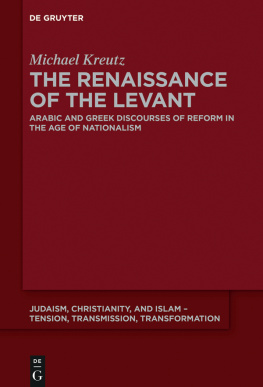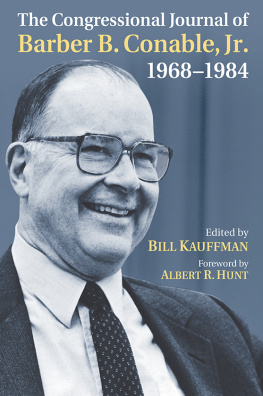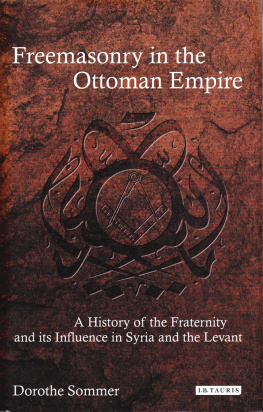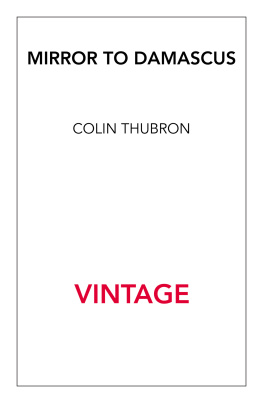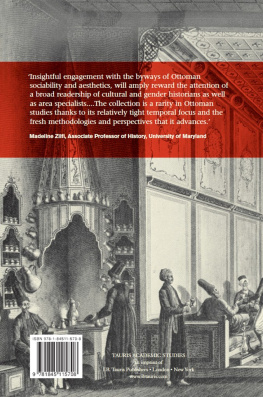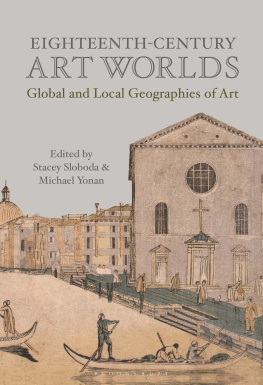Dana Sajdi - The Barber of Damascus: Noveau Literacy In The Eighteenth-Century Ottoman Levant
Here you can read online Dana Sajdi - The Barber of Damascus: Noveau Literacy In The Eighteenth-Century Ottoman Levant full text of the book (entire story) in english for free. Download pdf and epub, get meaning, cover and reviews about this ebook. year: 2013, publisher: Stanford University Press, genre: History. Description of the work, (preface) as well as reviews are available. Best literature library LitArk.com created for fans of good reading and offers a wide selection of genres:
Romance novel
Science fiction
Adventure
Detective
Science
History
Home and family
Prose
Art
Politics
Computer
Non-fiction
Religion
Business
Children
Humor
Choose a favorite category and find really read worthwhile books. Enjoy immersion in the world of imagination, feel the emotions of the characters or learn something new for yourself, make an fascinating discovery.

- Book:The Barber of Damascus: Noveau Literacy In The Eighteenth-Century Ottoman Levant
- Author:
- Publisher:Stanford University Press
- Genre:
- Year:2013
- Rating:3 / 5
- Favourites:Add to favourites
- Your mark:
- 60
- 1
- 2
- 3
- 4
- 5
The Barber of Damascus: Noveau Literacy In The Eighteenth-Century Ottoman Levant: summary, description and annotation
We offer to read an annotation, description, summary or preface (depends on what the author of the book "The Barber of Damascus: Noveau Literacy In The Eighteenth-Century Ottoman Levant" wrote himself). If you haven't found the necessary information about the book — write in the comments, we will try to find it.
Dana Sajdi: author's other books
Who wrote The Barber of Damascus: Noveau Literacy In The Eighteenth-Century Ottoman Levant? Find out the surname, the name of the author of the book and a list of all author's works by series.
The Barber of Damascus: Noveau Literacy In The Eighteenth-Century Ottoman Levant — read online for free the complete book (whole text) full work
Below is the text of the book, divided by pages. System saving the place of the last page read, allows you to conveniently read the book "The Barber of Damascus: Noveau Literacy In The Eighteenth-Century Ottoman Levant" online for free, without having to search again every time where you left off. Put a bookmark, and you can go to the page where you finished reading at any time.
Font size:
Interval:
Bookmark:
THE BARBER OF DAMASCUS
NOUVEAU LITERACY IN THE EIGHTEENTH-CENTURY OTTOMAN LEVANT
Dana Sajdi
Stanford University Press
Stanford, California
Stanford University Press
Stanford, California
2013 by the Board of Trustees of the Leland Stanford Junior University.
All rights reserved.
No part of this book may be reproduced or transmitted in any form or by any means, electronic or mechanical, including photocopying and recording, or in any information storage or retrieval system without the prior written permission of Stanford University Press.
Printed in the United States of America on acid-free, archival-quality paper
Library of Congress Cataloging-in-Publication Data
Sajdi, Dana, author.
The barber of Damascus : nouveau literacy in the eighteenth-century Ottoman Levant / Dana Sajdi.
pages cm
Includes bibliographical references and index.
ISBN 978-0-8047-8532-7 (cloth : alk. paper)
1. Ibn Budayr, Shihb al-Dn Amad, active eighteenth century. 2. al-Budayri, Ahmad, active eighteenth century. 3. BarbersSyriaDamascusBiography. 4. Arabic prose literatureEighteenth centuryHistory and criticism. 5. Literature and societyMiddle EastHistoryEighteenth century. 6. Middle EastIntellectual lifeEighteenth century. 7. Middle EastHistoryEighteenth centuryHistoriography. I. Title.
DS97.6.B83S25 2013
956.914403092dc23
2013005612
ISBN 978-0-8047-8828-1 (electronic)
For the barbers namesake
Contents
Illustrations and Maps
Acknowledgments
This book was written in fits and starts over a very long period of time and in a number of cities on several continents. Given the extraordinary temporal span and geographical expanse of the times and places of writing, the list of my debts is very long.
My first note of gratitude goes to Tarif Khalidi, who warmly received me in Cambridge in 1995 (and made me a much desired cup of Turkish coffee). Since then, we met few times, but our communication continued sporadically over the years. He read parts of the different iterations of my project to which he replied (extraordinarily swiftly) with the requisite encouragement, advice, and warnings. Similarly, Cemal Kafadar has always observed the project from a distance. At one point he asked me, Where is the social history? which question impelled me to reconceptualize my project entirely. Though the answer to the question caused significant delays, I continue to be grateful for the fact that it was posed at all.
Various colleagues have kindly read and commented on parts of the manuscript. I am grateful to Diana Abouali, Zeynep Altok, Asl Niyazolu, Adam Sabra, Ali Yaycolu, and the members of The Space and Place Seminar and The Ottoman Studies Seminar at the Research Center for Anatolian Civilizations, Istanbul, for their feedback. Three people, none from the field, read the manuscript in its entirety. Jim Bowley, who allowed me to experiment on him as the lay reader, wrote a wonderfully relevant and touching review. Robin Fleming, my colleague and mentor at the History Department at Boston College, took the interest and time to read all of my work, and to fix my eccentric English and bad punctuation habits. I will always be grateful for her professional support (and gardening tips!). As usual, Shahab Ahmed read yet another version of the manuscript with devotion and attention. Since he too lived with the barber for a long time, I am thankful to him that he was able to sustain interest and still ask pertinent questions till the very end. My indebtedness, intellectual and otherwise, to Shahab is historical and foundational: I effectively learned English from him.
There are many colleagues who have lent their support over the years and whose kindness restores my faith in humanity (and in email). I wish to single out Steve Tamari, with whom I had a 14-year professional email correspondence before we even met. He shared with me the notes of his own research and allowed me to steal his title, The Barber of Damascus. Steves collegiality and generosity are exemplary. Similarly, Zayde Antrim and I have historically shared the Damascus fever, but we met properly only once. Zayde kindly read my work as it evolved and has been a true friend in need. Derin Terziolu, whose work I have always admired and whose relationship to text is one that I wish to emulate, also came through at very short notice. Michael Cook was an ideal employer and great supporter during a postdoctoral stint at Princeton. Richard Bulliet, my mentor at Columbia University, always inspired.
At Boston College, I am indebted to my students who read parts of the manuscript or helped me in my research. Sandy Williams and Stuart Pike, both wonderful thinkers and writers, read and helped me edit it. Sophia Moradian turned out to be a fiend of a research assistant: she organized and systematized my digital library with extraordinary efficiency and generated this books bibliography in no time. These and other students at Boston College have given me much joy and satisfaction in my profession.
I am grateful to Michael Swanton and Kerry Burke at Media Technology Services at Boston College, who helped me with image scanning and tossed around map ideas. However, it was a student, Emma Sobbota, who adapted the busy map of intramural Damascus and made it legible.
This project would not exist had it not been for the unique manuscript of the barbers history lodged at the delightful Chester Beatty Library, where the curator of the Islamic collections, Elaine Wright, lent her cooperation and support throughout. At the same library, I thank Francis Narkiewicz for facilitating the reproduction of images. Jan-Eric Ericson of the National Library of Sweden delivered to me what became the book cover image in no time. Andrea Schuler, the Aga Khan Visual Archivist at MIT Roth Library of Architecture and Planning responded to my online general query for imagesreproduced and published gratiswith exemplary efficiency. I am indebted to Gerard Degeorge for permitting me to reproduce an image from his book, and to Dorothe Sack, who has kindly allowed me to adapt her wonderful maps.
A series of small research expense grants from Boston College allowed me to go back to Damascus several times to continue my research and covered some of the expenses related to the research, writing, and publication of this project. I thank the Norma Jean Calderwood Chair in Islamic and Asian Art at Boston College, occupied by Sheila Blair and Jonathan Bloom, for generously underwriting the cost of the illustrations.
Kate Wahl, at Stanford University Press, has been an exemplary editor. The professionalism and efficiency that she, Frances Malcolm, and Tim Roberts have shown made the process relatively painless. I am very grateful to Tom Finnegan for his conscientious but noninterventionist editing. To the two anonymous reviewers I am much obliged. Their observations, I believe, improved the quality of this product, and their encouragement made for an ideal academic exchange of critical helpfulness. Any mistakes in this book are not theirs but solely my own.
My global network of friends who put up with me (and sometimes put me up) have been invaluable for my sustenance and wellbeing over the years. In Cairo, I always found a home with Nabila Masralli and Pascale Ghazaleh. In Montreal, Rania Urabi suffered the cold with me. In Berlin, Dyala Hamzah, Zafer Yenal, and Farish Nour were social and intellectual partners in crime. In Istanbul, Rachel Goshgarian, Sofia Georgiadou, Galina Tirnanic, Ekin Tualp, and Leah Long danced the nights away with me. In New York, Joseph Massad, Lale ner, Moeen Lashari, Nisreen Alami, Hadi Ghaemi, Mahnua Leng, and Josh Zinner allowed me into their homes and hearts. Sarahleah Whitson (in Cairo, New York, Amman, and wherever else we have met in this world) has been a constant and consistent surrogate sister since I left home in 1986. In London, Izzat Dawazeh, taken in limited doses, is a constant source of joy, silliness, wit, and even comfort. Finally, Johannes Walter, Sanja Sever, Diana Abouali, Ilham Khuri-Makdisi, Sahar Bazzaz, and Jim Bowley have given me reason to think of Cambridge-Boston as home.
Next pageFont size:
Interval:
Bookmark:
Similar books «The Barber of Damascus: Noveau Literacy In The Eighteenth-Century Ottoman Levant»
Look at similar books to The Barber of Damascus: Noveau Literacy In The Eighteenth-Century Ottoman Levant. We have selected literature similar in name and meaning in the hope of providing readers with more options to find new, interesting, not yet read works.
Discussion, reviews of the book The Barber of Damascus: Noveau Literacy In The Eighteenth-Century Ottoman Levant and just readers' own opinions. Leave your comments, write what you think about the work, its meaning or the main characters. Specify what exactly you liked and what you didn't like, and why you think so.

